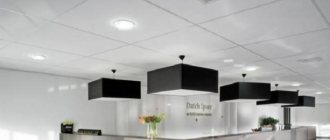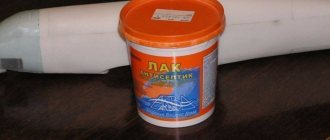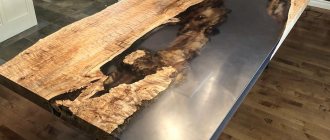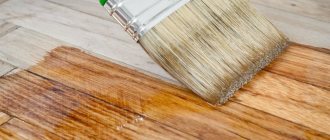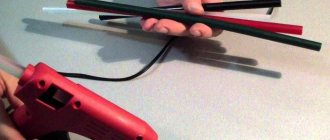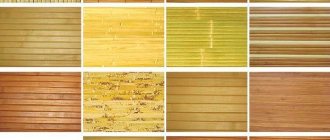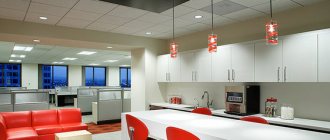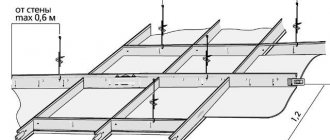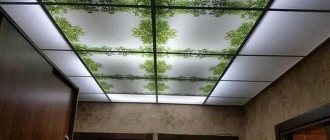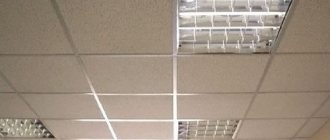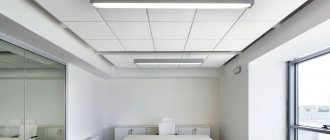Home / Types of ceilings / Suspended ceilings / Using AGShT slabs for ceiling finishing
Quite often a situation arises in which it is necessary to soundproof the ceiling and at the same time make it beautiful and functional. For this purpose, various materials are used, analogues of which were produced back in the seventies of the last century. It is precisely these finishing methods that include covering the ceiling with AGShT type slabs.
Principle of operation
The operating principle of the pumping station can be divided into 4 stages:
- The pump pumps water into the storage tank (hydraulic accumulator), after which the pressure switch turns off the pump.
The unit goes into standby mode, in which the pressure in the second part of the accumulator reaches the set value.
Ready mode - taps can be opened, water can be used.
Reducing the water pressure in the tank restarts the station pump and so on.
The design of the hydraulic accumulator and the operating principle of the automation
Essentially, a hydraulic accumulator, or as it is also called a hydraulic tank, is a container consisting of two parts. One is hollow and is designed to store water, and the second is made in the form of a rubber bulb filled with air. Water entering the accumulative part of the hydraulic tank under pressure compresses the bulb with air. Having reached the required pressure, the automation (pressure switch) turns off the water supply. When the tap is opened, the air in the bulb displaces the accumulated water, and the check valve will prevent water from returning to the hydraulic tank. When the water pressure drops to the level assigned to the automation, the pumping station turns on again.
Automation also monitors temperature. If the NS overheats, it turns off, and the water serves as a natural coolant.
Need to know!
The advantage of a pumping station over a conventional submersible pump for a well or borehole is that even in the event of a temporary lack of electricity, you always have a small supply of water. Moreover, considering that tanks can be 24, 50 or more liters, this is a significant convenience, and as described above, it significantly reduces the number of pump on/off cycles. This way, washing your hands or a liter or two of water for the kettle will not start the pump every time.
- To water the garden or supply water to the pool, a pump station with a tank will turn on and off frequently (compared to a simple pump).
The pressure may drop slightly if hot water is consumed when connected to the autonomous heating system - this will cause the boiler to turn on or off unscheduled.
Such pumping stations are used if the suction depth (water surface) does not exceed 9 meters. If the water lies deeper, then you should choose deep-well pumps or pumps for wells.
Acoustic products “AKMIGRAN” and “AKMINIT”
The material is in demand in theaters, concert halls and conservatories; The base of the slabs is a perforated gypsum mass with a fabric backing. In addition, plastic boards are not afraid of flooding: they can simply be washed using soapy water, and the appearance will return to its original appearance.
One of the advantages of using such finishing is increasing the soundproofing characteristics of the ceiling structure, as well as increasing its fire resistance. Asbestos fibers have excellent fire resistance, and the structure of the products improves the acoustic comfort in the room. Simplicity of installation makes it possible to install the structure on your own, without the involvement of outside specialists.
Please note: in this sense, they are not inferior to PVC wall panels; at the same time they are noticeably cheaper. The main advantage of wooden ceiling tiles is their stunning appearance. In addition, cork tiles perfectly dampen sounds, at least not inferior to AGSh slabs in this regard
Installation of a tiled ceiling is more than simple and can be done even by a person with minimal construction skills, see Ceiling tiles: types and installation features
In addition, cork tiles perfectly dampen sounds, at least not inferior to AGSh slabs. Installation of a tiled ceiling is more than simple and can be done even by a person with minimal construction skills, see Ceiling tiles: types and features of installation.
All you need is a set of basic tools and a little self-confidence. Good luck with the renovation! AGShT panels are square parts with large perforations, mounted on a suspended base used in Armstrong-type ceilings.
They are made from a gypsum mixture reinforced with fiberglass, covered on both sides with sheets of cardboard. Marking of AGShT parts indicates that the slabs are made with an underlying textile layer. Exactly the same parts, but without a textile backing, are marked with the designation AGSh. Similar materials are used to improve the sound insulation of rooms. The main feature of AGShT panels is the ability to use them as a soundproofing structure without additional layers of soundproofing materials.
To do this, the coating must be at some distance from the base ceiling. According to the standard, this distance should be 50 or millimeters. After the ceiling structure has been assembled, it can be painted with water-based paints. The coating slabs themselves are produced in white, which allows you to give them any shade if desired.
Akmigran slabs, used for finishing ceilings, are panels made of granulated or glass wool. During the production process, cotton wool and starch are added to the main components, thanks to which the final product acquires a high level of sound insulation properties. Akmigran is produced using the pressing method. The production process is as follows:. As many consumers have noticed, the Akmigran ceiling resembles an Armstrong-type system.
The exception is the fact that to assemble a ceiling from Akmigran panels you will need to invest much more money and install a rather complex fastening system.
Akmigran slabs, used for finishing ceilings, are panels made of granulated or glass wool. During the production process, cotton wool and starch are added to the main components, thanks to which the final product acquires a high level of sound insulation properties. Akmigran is produced using the pressing method. The production process is as follows:.
Akmigran
Akmigran - tiles made of granulated or glass wool with the addition of starch and cotton wool, which are characterized by high sound-absorbing ability. Akmigran is produced by pressing. Mineral wool is granulated and processed into particles with a diameter of 2–15 mm. Then a binding solution is prepared from cold water, starch and white clay. All components are thoroughly mixed and heated to a temperature of 85 – 90 °C.
A stabilizer, borax or boric acid, is added to the binding solution. Granulated mineral wool is added to the resulting mixture. After molding, tiles are obtained. They are covered with microcracks. However, this is not a defect. On the contrary, cracks increase the soundproofing properties of acmigran. The slabs are dried for 16–18 hours at a temperature of 140 °C. At the final stage, the acmigran is polished and cut into tiles measuring 300 × 250 mm, 300 × 300 mm, 600 × 600 mm, 800 × 250 mm and 20 mm thick. The tiles are painted white. The surface of acmigran is porous. The texture of the tile can be corrugated, with grooves or cracks. Akmigran is used for cladding rooms with high noise levels.
Popularity of coverage
Why are ceiling tiles in demand by consumers? What are their advantages? For what reason should you choose this coating over alternative options?
What will you gain by choosing slabs for ceiling repair? Advantages:
save time (there is no need to level, putty, or even plaster the base); reduce costs (the types of work listed above require the purchase of many materials and tools); achieve a perfectly smooth ceiling; you can do the installation yourself (this process is easy and understandable); do not turn your home into a dump, as would be the case with a traditional ceiling renovation; insulate your home, which is very important in the current conditions; protect the apartment from neighbor or street noise (there are special soundproofing tiles for the ceiling on sale); you will achieve the desired color, relief and appearance of the ceiling, since you see the result immediately (even at the time of purchasing the products), and are not afraid that the workers will present you with a “surprise” when making a traditional coating; You will save your nerves, and, consequently, your health. Manufacturers continue to pamper us with new materials that make the repair process easier.
Manufacturers continue to pamper us with new materials that make the repair process easier.
The wisdom of choosing products
Let’s say you’ve decided what kind of material you want slabs from, how you plan to install them, taken into account the special requirements for the material, decided on the dimensions, found the most affordable option for you, calculated the ceiling area, purchased tools. We even took a master class on how to carry out such work. The time has come to make your planned purchase. It is better, of course, for you to do this yourself, carefully inspecting and checking each unit of goods.
By the way, you have the opportunity to become the author of a special project; do not be afraid to experiment with ceiling design
So what are your verification steps? Remember:
- the structure and density of the coating along the entire perimeter of the product must be uniform (no dents, bulges or waves should be present on the surface);
- any of the slabs must have smooth edges, that is, not deformed, not broken, not concave (don’t be too lazy to review each one, especially if the price of the product is “biting”);
- if there is a pattern on the products, check its clarity, because blurred lines or erased fragments will not decorate your home;
- the edges of the slabs must be perfect, since roundings and dents on materials of this format make their installation extremely difficult, if not completely impossible, in which case the product will simply have to be thrown away.
If you are primarily concerned about the shade of the ceiling, be careful: be sure to ask your consultant whether the material you have chosen can be coated with paint, and whether there are any nuances with this particular block of work.
Application area
1.1 The scope of application of suspended ceilings of the “Akmigran” type are buildings for various purposes: administrative, cultural and domestic, educational, industrial with a relative humidity in the premises of 60 - 70% and a temperature from 5 ° C to 30 ° C.
They are used both decorative and in the form of acoustic elements of premises, enclosing the above-ceiling space in which various engineering networks and communications for air conditioning, electric lighting and low-current devices, etc. are located, and increasing the comfort of the premises.
1.2 This technological map discusses the issues of installing decorative suspended ceilings on a metal frame with front elements made of Akmigran slabs
1.3 Decorative suspended ceiling slabs “Akmigran” with a finished front surface are made from granulated mineral wool, a starch binder with water-repellent, antiseptic and other additives. Overall dimensions of suspended ceiling slabs, mm: length - 300, width - 300 or 250, thickness - 18. Weight of each slab - 0.7 kg. The weight of one square meter of suspended ceiling made from Akmigran slabs, excluding outlets, is 10.3 kg.
1.4 The design of a suspended ceiling, consisting of a “black” and “clean” frame with front elements made of Akmigran type slabs, is shown in Figure 1. The distance from the horizontal rods of the steel frame to the level of the “clean” ceiling, depending on the design solution, is 160 - 320 mm or 80 - 150 mm.
The “black” frame is made of vertical outlets from the ceiling and horizontal steel rods or angle profile elements made of VSt3 steel, welded to each other. The outlets laid during the installation of floor slabs are made of round reinforcing steel. The length of the outlets depends on the height of the ceiling space.
The “clean” frame consists of hangers with fasteners and guide aluminum profiles into which the suspended ceiling slabs are inserted and moved to the design position.
1 - reinforced concrete floor slab; 2 - release of reinforcement from the ceiling; 3 - horizontal rod of the steel frame; 4 — connecting plate; 5 - guide; 6 - rider; 7 — suspension; 8 — suspension bracket; 9 - key; 10 - bolted connection; 11 — “Acmigran” plate; 12 - comb.
Picture 1
— Structural diagram of a suspended ceiling with front elements made of Akmigran slabs
The design of suspended ceilings made from Akmigran slabs was developed by the Mosproekt-2 Institute.
1.5 The aluminum profile guide is attached to the horizontal rods of the “black” frame using a hanger made of galvanized sheet steel in accordance with GOST 14918-80*.
1.6 Akmigran acoustic slabs are connected to each other during the installation process using fiber dowels. The slabs are supported along the contour of the room on a metal molding (corner).
1.7 The small masses and dimensions of the structural elements of suspended ceilings allow installation work to be carried out manually.
1.8 The design solution of the suspended ceiling allows the installation of slabs from below and the removal of individual elements on any section of the ceiling when repairing wiring, installing and replacing lamps.
II. ORGANIZATION AND TECHNOLOGY OF THE CONSTRUCTION PROCESS
2.1. Suspended ceilings on a metal frame, made of AGShT slabs, are made in accordance with the working drawings of the album “Typical details of residential and civil buildings, section 6 “Suspended ceilings” in compliance with the requirements of SNiP III -21-73. “Rules for production and acceptance of work. Finishing coatings for building structures."
2.2. Before installation of the suspended ceiling begins, construction, installation and special work must be completed, including finishing work associated with wet processes (plastering work, installation of cement screeds).
2.3. Temperature and humidity conditions in the room must correspond to operating conditions. In winter, the air temperature should not be lower than +10 C, the relative humidity should not be higher than 70%.
2.4. Before installation begins, the holes provided for by the design must be drilled or cut in the slabs for the installation of lighting fixtures and ventilation grilles.
2.5. Aluminum guides (SPA-2020 profiles) 6 m long are transported in bags, which are secured with metal tapes to prevent deformation, or in special containers. The guides should not have curvatures of more than 0.5 mm per 1 m.
2.8. Acoustic gypsum boards AGSHT (TU 490-1-283-73) are perforated gypsum dry plaster with an underlying layer of fabric. The slabs are produced by the Pavshinsky plant of thermal insulation and gypsum products. The dimensions of the slabs are 500 ´ 500 ´ 85 mm. The diameter of the perforation hole is 8-10 mm. The slabs are transported by road under conditions that protect the slabs from moisture and mechanical damage.
AGShT slabs must be stored in closed heated rooms at a relative air humidity of no more than 70%, in stacks no more than 2 m high. The appearance of the slab must correspond to the standards. Near the front side of the slabs, corners, ribs, cracks in the slabs, as well as cardboard breaks in the perforation holes are not allowed. The slabs must have a regular rectangular shape and a smooth front surface.
2.7. Guide hangers and connecting linings are made of galvanized sheet steel (GOST 14918-69).
2.8. The rough metal frame consists of load-bearing reinforcement with a diameter of 18 mm, welded to outlets from reinforcement with a diameter of 12 mm, fixed in the floor seams or released from the floor slabs.
2.9. Installation of a clean frame and installation of slabs is carried out in the following technological sequence:
checking the dimensions of the ceiling with a breakdown of the axes of the room;
installation of suspensions not a rough frame;
attachment of riders to guides;
installation of guides with alignment of the distances between them;
cutting stiffeners;
laying row and frieze slabs AGShT with installation of stiffeners;
checking the horizontality of the ceiling.
2.10. Checking the dimensions of the ceiling is carried out diagonally, for which the axes of the room are divided, starting from the middle of the ceiling to the walls.
Specifications
Before using linear panels for facade cladding, it would be useful to familiarize yourself with their main characteristics. The technical characteristics of the lamellas can vary significantly depending on the material used (steel or aluminum) and the thickness of the lamellas, but there are characteristics common to all linear panels:
- operating temperature range of the cladding from -50 to +50C;
- the service life is on average 25-30 years, depending on the thickness of the sheet and the type of protective and decorative coating;
- the length of the lamellas can vary from 0.9 to 6 m, width - from 140 to 400 mm. The thickness of the lamella can be from 0.45 to 1 mm;
- the weight depends on the thickness of the rolled metal and the type of protective coating, but rarely exceeds 7 kg/m2;
- according to the flammability class, all linear panels belong to the category of non-combustible materials;
- the material is resistant to sudden temperature changes, ultraviolet radiation and mechanical stress;
Thanks to these technical characteristics, the material is widely used in industrial and civil construction.
Disadvantages of finishing the ceiling with Akmigran slabs
Despite the large number of advantages, we should not forget that any construction product has its disadvantages. Unfortunately, Akmigran slabs also have them.
As practice and consumer reviews show, this material has one significant drawback. During installation work, the height of the ceilings suffers significantly. This is due to the fact that to attach the slabs, a frame base must be provided, which takes up a lot of space and space.
Some note that the disadvantage is the lack of a varied color palette. The slabs are sold only in white, but if necessary, upon individual order, the material can be given any color. It is also worth noting that white color is universal, as a result of which it can be used for any room. It is for this reason that this point remains in doubt, since it is both a disadvantage and an advantage.
When describing the composition of Akmigran slabs, the manufacturer indicates a word unfamiliar to many consumers - asbestos. Undoubtedly, this scares many, but it is necessary to understand that during operation, asbestos fibers are not released from the facing material, as a result of which there is no need to be afraid of this component.
Akminit
Acminite is very similar in characteristics to acmigran. However, the production technologies of these plates have significant differences. For acminite, a wetter mixture is used. The plates are made in a more complex way. Press rollers compact the acminite mixture by squeezing out excess liquid. As a result, akminite slabs are stronger than akmigran, and their ability to absorb sound is higher. In addition, they consume less raw materials, the drying process is faster, and the tiles themselves warp less during use. After drying, the akminite slabs are treated with abrasive materials, dents are made using special blunt teeth, and holes are drilled. All this is needed to give the surface of the slabs a certain texture. Natural stone tiles, which are designed for laying using Western technologies, are thinner than domestic products. The thickness of foreign granite tiles for interior decoration is 10-15 mm, marble tiles - 10 mm.
Scope of application
Based on the main characteristics of these panels, it can be assumed that they should be used where good sound insulation and absorption of extraneous noise are required. It is for such purposes that ceiling cladding with AGShT type slabs is used:
- In meeting rooms of enterprises or offices.
- To improve acoustics in office work areas.
- As finishing of floors of trading floors.
- In educational and medical institutions.
- For decoration of ceilings of entertainment centers, cafes and restaurants.
These materials are rarely used for decorating residential premises. However, if the desire arises, it will not be difficult to assemble such a ceiling - the installation process is very similar to the installation of conventional solutions from the Armstrong company and does not require special equipment or qualifications.
How Akmigran panels are arranged
The structure of the new ceiling finishing material is in many ways reminiscent of plasterboard or sandwich panels. Structurally, Akmigran slabs are a three-layer material with an inorganic filler:
- Inside the panel there is a filler made of granulated asbestos fiber impregnated with a binder. The result is a porous, non-flammable, lightweight and at the same time durable structure that absorbs and dissipates sound waves well;
- The front and back surfaces of the panel are sealed with a protective layer of cardboard based on pressed and glued organic and mineral fiber. This is done in order to form a smooth surface of Akmigran, to give it a more expressive appearance;
- Most ceiling panels are made with perforations over the entire surface area. Holes with a diameter of 2-5 mm are filled in increments of 5-10 mm.
The presence of perforations on ceiling cladding with Akmigran type slabs, photo, increases the decorative qualities of the material and at the same time contributes to better absorption of noise and sounds.
For your information! Panels without perforation are often covered with microcracks, but they do not affect the strength and absorption characteristics of the ceilings, so they are not considered defects.
At the ends of the slab material, grooves are formed with a paraffin layer applied. This makes it easier to slide when laying the panels and at the same time serves as protection against the penetration of water vapor. The surface of Akmigran must be sanded and most often painted with mineral paint.
According to the manufacturers, the ceilings can be used in the temperature range from 20 to 40
O
C, with air humidity up to 95%. In such conditions, Akmigran's asbestos matrix is capable of absorbing noise of any intensity with an efficiency of up to 95%.
This is interesting: Stretch ceiling: curtain rod in a niche
Installation methods
It makes no sense to consider in detail the process of installing the ceiling - it is similar to assembling Armstrong-type structures. However, this only applies to the classic installation option. At the same time, there are two more ways to lay panels, which differ from the most popular option.
The first is for glue or nails. Such panels were mounted with glue before and after gluing; it was extremely difficult to remove the coating, which made subsequent repairs difficult. Therefore, gluing such panels directly to the ceiling is not recommended.
Sometimes, parts are nailed or screwed to wooden structures. In modern houses, the floors are made of concrete and therefore this method can only be used in private or country houses.
The third mounting option is on a wooden sheathing. This is the most functional way. For installation, a sheathing is assembled from wooden parts and fragments of the slab covering are attached directly to it.
What kind of plates are these?
Panels called acmigran slabs are a special type of tile made from a mixture of mineral wool, asbestos fiber and clay. During production, many microcracks form on the surface of such panels, which are not a defect. On the contrary, this increases the functionality of such coatings, since the presence of microcracks increases the soundproofing qualities of the material. Sometimes the surface has microperforations.
Installation of the covering elements is carried out on a frame used for all Armstrong-type ceilings, largely unifying this solution. Like all materials intended for installation on such bases, acmigran panels are a finishing option that is more suitable for decorating the ceilings of office or retail spaces, but this does not exclude the possibility of using them for decorating apartments or private houses.
Ceiling cladding with Akmigran type slabs: on a wooden frame with a spacing of 5 cm
LOCAL RESOURCE GIVEN GESN 15-01-047-02
| Name | Unit |
| Ceiling cladding with Akmigran type slabs: on a wooden frame with a spacing of 5 cm | 100 m2 of cladding surface |
| Scope of work | |
| 01. Installation of fastening elements. 02. Assembly and installation of frames. 03. Installation of facing slabs. 04. Finishing the cladding surface. |
PRICE VALUES
The price list shows the direct costs of the work for the period of March 2014
for the city of Moscow, which are calculated on the basis of
2014 standards with additions 1
by applying indices to the prices of the resources used.
2000
federal prices .
The following indices and hourly rates from the “Union of Cost Estimating Engineers” were used: Index to the cost of materials: 7.485
Index to the cost of machines:
11.643
Hourly rates used: The monthly wage at a given hourly rate is indicated in parentheses.
Hourly rate 1st category: 130.23 rubles. per hour ( 22,920
) rub.
per month. Hourly rate 2nd category: 141.21 rubles. per hour ( 24,853
) rub.
per month. Hourly rate 3rd category: 154.46 rubles. per hour ( 27,185
) rub.
per month. Hourly rate 4 categories: 174.34 rubles. per hour ( 30,684
) rub.
per month. Hourly rate 5th category: 200.84 rubles. per hour ( 35,348
) rub.
per month. Hourly rate 6th grade: 233.96 rubles. per hour ( 41,177
) rub. per month.
By clicking on this link, you can see this standard calculated in 2000 prices. The basis for applying the composition and consumption of materials, machines and labor costs are GESN-2001
LABOR COSTS
| № | Name | Unit Change | Labor costs |
| 1 | Labor costs of construction workers Grade 3.5 | person-hour | 649 |
| 2 | Labor costs for drivers (for reference, included in the price of the EV) | person-hour | 0,27 |
| Total labor costs for workers | person-hour | 649 | |
| Workers' compensation = 649 x 164.4 | Rub. | 106 695,60 | |
| Payroll for drivers = 284.2 (for calculating invoices and profits) | Rub. | 284,20 |
Determining the area of the apartment walls
OPERATION OF MACHINES AND MECHANISMS
| № | Cipher | Name | Unit Change | Consumption | St. unit.Rub. | TotalRub. |
| 1 | 030954 | Single-mast lifts with a lifting capacity of up to 500 kg, lifting height 45 m | mach.-h | 0,27 | 363,96 | 98,27 |
| 2 | 040502 | Installations for manual arc welding (DC) | mach.-h | 2 | 94,31 | 188,62 |
| 3 | 330206 | Electric drills | mach.-h | 5,35 | 22,7 | 121,45 |
| 4 | 331531 | Electric circular saw | mach.-h | 0,15 | 11,06 | 1,66 |
| 5 | 400001 | Flatbed vehicles, load capacity up to 5 tons | mach.-h | 1,79 | 1014,92 | 1 816,71 |
| Total | Rub. | 2 226,70 |
CONSUMPTION OF MATERIALS
| № | Cipher | Name | Unit Change | Consumption | St. unit.Rub. | TotalRub. |
| 1 | 101-0359 | Water-dispersed polyvinyl acetate paints VD-VA-27A, E-VA-27T white | T | 0,016 | 115800,44 | 1 852,81 |
| 2 | 101-0383 | Oil and alkyd thickly rubbed paints, zinc MA-011-0 | T | 0,002 | 117566,9 | 235,13 |
| 3 | 101-0609 | Adhesive rubber mastic, grade KN-2 | kg | 8 | 62,57 | 500,56 |
| 4 | 101-0627 | Combined drying oil, grade K-2 | T | 0,017 | 155500,88 | 2 643,51 |
| 5 | 101-1504 | Electrodes with a diameter of 2 mm E42 | T | 0,02 | 102342,4 | 2 046,85 |
| 6 | 101-1714 | Construction bolts with nuts and washers | T | 0,0521 | 67664,47 | 3 525,32 |
| 7 | 101-1757 | Rags | kg | 0,2 | 13,62 | 2,72 |
| 8 | 101-1805 | Construction nails | T | 0,0041 | 89655,33 | 367,59 |
| 9 | 101-2313 | Technical sodium silicofluoride, grade I | T | 0,004 | 52862,81 | 211,45 |
| 10 | 102-0025 | Edged softwood bars 4-6.5 m long, 75-150 mm wide, 40-75 mm thick, grade III | m3 | 1,05 | 9633,2 | 10 114,86 |
| 11 | 104-0095 | Cladding slabs | m2 | 102 | 1137,72 | 116 047,44 |
| 12 | 110-0115 | Sovol plasticizer | T | 0,004 | 83914,34 | 335,66 |
| 13 | 113-0005 | Ammonium sulfate (ammonium sulfate) purified | T | 0,026 | 93457,71 | 2 429,90 |
| 14 | 113-0006 | Ammonium phosphate disubstituted (diamonium phosphate), grade B | T | 0,026 | 60261,74 | 1 566,81 |
| 15 | 113-0090 | Varnish XC-76 chemical resistant | T | 0,075 | 157289,79 | 11 796,73 |
| Total | Rub. | 153 677,34 |
TOTAL BY RESOURCES: 155,904.04 RUB.
TOTAL PRICE: RUB 262,599.64.
You can see this standard calculated in 2000 prices. by following this link
The price is compiled according to the standards of GESN-2001 as amended in 2014 with additions 1
in prices
of March 2014.
To determine intermediate and final price values, the DefSmeta program was used
Estimates for building a house, repairing and finishing apartments - DefSmeta
Renting a program
The program provides an assistant who will turn drawing up estimates into a game.
Types of tiles for suspended ceilings
Ceilings can differ not only in the method of their fastening, but also in the type of tiles themselves.
What materials can be used to create ceiling tiles?
In what cases does it make sense to use them?
Ceiling cladding with Akmigran or Akminit slabs is used when it is necessary to ensure fire safety and minimal hygroscopicity of the ceiling. The basis of the slabs is granulated mineral wool and asbestos fiber. Kaolin, a fire-resistant clay, is used as a binder.
The production technology provides a certain number of microcracks in the material; Thanks to them, the sound absorption of these ceiling tiles is improved.
These tiles combine fire resistance and low hygroscopicity.
Cladding of ceilings with AGShT slabs is necessary primarily in order to increase the soundproofness of the ceiling and provide the best acoustics without re-reflections of acoustic vibrations.
The material is in demand in theaters, concert halls and conservatories; The basis of the slabs is perforated gypsum mass with a fabric backing. AGSh slabs differ from AGShT only in the absence of this substrate.
Plastic decorative ceiling tiles (usually translucent acrylic) give the illusion of depth, making the room visually appear much taller. It can hide lighting systems, giving diffused light.
Translucent acrylic tiles allow you to illuminate the ceiling from above.
In addition, plastic boards are not afraid of flooding: they can simply be washed using soapy water, and the appearance will return to its original appearance.
Please note: in this sense, they are not inferior to PVC wall panels; at the same time they are noticeably cheaper. Wooden decorative tiles are much more expensive than previous materials
In addition, its performance properties are noticeably worse: wood is afraid of moisture, burns and rots. However, after treatment with antiseptic compounds and varnishing, some of the shortcomings will be forgotten
Wooden decorative tiles are much more expensive than previous materials. In addition, its performance properties are noticeably worse: wood is afraid of moisture, burns and rots. However, after treatment with antiseptic compounds and varnishing, some of the shortcomings will be forgotten.
Agree, this ceiling looks very impressive.
The main advantage of wooden ceiling tiles is their stunning appearance. In addition, cork tiles perfectly dampen sounds, at least not inferior to AGSh slabs.
- Mirror glass tiles. It visually expands the room to the greatest extent, but requires that you take the strength of the frame very seriously: the heavy weight and sharp edges of the tiles can cause trouble if they fall.
- Metal. It is durable and not afraid of water; but will not provide sound insulation.
Aluminum ceiling tiles: an almost eternal material that allows all sounds to pass through.
This is interesting: Installation of a single-level stretch ceiling in an apartment
Types of tile ceiling
Let's first figure out what tiled ceilings are based on the installation method.
Under the sticker
These ceilings were very popular in our country about 15-20 years ago.
- Adhesive PVC ceiling tiles are the easiest way to correct minor surface defects from the ceiling without major repairs . After treating the surface with a primer, the tiles can even be glued to whitewash.
- The cheapness of such repairs is second only to whitewashing with lime.
- Repairs using adhesive ceiling tiles can be done by a novice without any construction experience.
How to put this tile on the ceiling:
- The ceiling is cleaned of whitewash (see How to clean a ceiling from whitewash: effective options) and peeling plaster or treated with a penetrating primer.
- Polystyrene foam or polystyrene tiles are glued to the surface using universal adhesive. Typically white. The edges of the tiles can be parallel to the walls or located diagonally.
- If necessary, the joints of tiles for the ceiling and walls use a ceiling plinth - also made of polystyrene foam or polystyrene.
A simple and cheap way to repair a ceiling using foam tiles is going out of fashion.
Nowadays, sticker-on ceiling tiles are gradually becoming a thing of the past, giving way to stretch and suspended ceilings.
What are the disadvantages of this design? Why is its popularity falling?
- The surface of polystyrene foam and polystyrene collects dust, soot and grease. And if the dust is easy to wipe off with a damp cloth, then the grease and soot practically cannot be washed off.
Please note: polystyrene tiles with a protective film do not have this drawback. Its surface is easy to clean using any cleaning agents except abrasive ones.
- The ceiling as a whole does not have a very presentable appearance. The seams between the slabs are visible. Stretch or plasterboard ceilings look much better.
- Finally, such a ceiling can mask only minor surface defects. Alas, builders often leave behind floors with a difference in height between the slabs of several centimeters. Sticking thin tiles will only highlight these defects.
Suspension
But we will linger on this type of ceiling.
What are its features?
- Plates are not glued to the ceiling . They are laid on a special lattice frame, separated from the ceiling at some distance.
The tiles are simply placed on top of the frame.
- If so, the distance between the suspended ceiling and the tiles can be used to hide plumbing, wiring, ventilation and communications of the air conditioning system.
- Significant differences in height and surface defects will also be hidden. All that will remain before your eyes is the perfectly flat surface of the ceiling.
- The modular design and laying of tiles without fastening means that any area can be repaired with little effort, without the involvement of builders.
The most typical example of troubles that a ceiling can suffer from is if water spills onto the tiles through the ceiling . If the tiles are glued, this means that you will have to tear off part of the ceiling covering, putty the surface and re-glue new tiles.
Here we simply remove the tiles with traces of stains from the grate and put new ones in their place.
For a painted ceiling, flooding also means serious repairs.
- The main disadvantage of these tiled ceilings is the same as with all basic suspended structures. The room will become lower by 5 - 25 centimeters. If so, in Khrushchev and Brezhnev buildings you should think twice before settling on such a ceiling.
Characteristics
It is now almost impossible to find slabs on sale that have the original AGShT marking. The fact is that such materials were produced back in the days of the USSR and now only their analogues are produced. However, apart from the dimensions of the parts themselves, no other characteristics of the products have changed.
On the site of the plant that previously produced similar products, the production of materials offered under the Knauf brand is located. All characteristics of the soundproofing panels produced at this enterprise correspond to the original products marked AGShT. Therefore, except for size, modern analogues will not differ in any way from their predecessors.
- Length/width – 60 by 60 or 60 by 120 centimeters
- The thickness of the panels can be different - from 10 to 15 millimeters
- Sound absorption – from 0.55 aw to 0.80 aw
Common characteristics for all types of such parts will be good moisture resistance and fire safety. For the wettest rooms, such as bathrooms, such coatings are not suitable, but in other places they can be used without restrictions.
Installation methods
It makes no sense to consider in detail the process of installing the ceiling - it is similar to assembling Armstrong-type structures. However, this only applies to the classic installation option. At the same time, there are two more ways to lay panels, which differ from the most popular option.
The first is for glue or nails. Such panels were mounted with glue before and after gluing; it was extremely difficult to remove the coating, which made subsequent repairs difficult. Therefore, gluing such panels directly to the ceiling is not recommended.
Sometimes, parts are nailed or screwed to wooden structures. In modern houses, the floors are made of concrete and therefore this method can only be used in private or country houses.
The third mounting option is on a wooden sheathing. This is the most functional way. For installation, a sheathing is assembled from wooden parts and fragments of the slab covering are attached directly to it.
Assembly of the structure
The main point of performing installation work will be the development of a diagram or drawing of the future ceiling. This is necessary to avoid annoying mistakes at the remaining stages of assembling the composition. All lamps should be provided and the exact locations of their installation should be determined, since electrical wires will need to be laid in advance to connect them.
After drawing up the diagram, installation of the frame base begins. It consists of two parts: a power part, which carries the entire mechanical load, and a decorative part, which serves to fix the external elements of the composition. The power part is installed first, followed by the decorative part.
Load-bearing parts in the form of hangers are attached to the ceiling with dowels, and decorative profiles are attached to them, serving as fastenings for the panels. In shape, these profiles resemble rails, between which covering elements are inserted.
Assembling the structure is very simple and even an inexperienced person can do it. The final stage of the work will be the installation of lamps and the necessary decorative details, if they are provided for in the design.
Linear panel manufacturing technology
For the production of linear panels, a special technology has been developed that allows us to produce products that meet all the requirements of international quality standards.
Most often, linear panels are made of galvanized steel. A protective polymer or powder coating is applied to both sides of the product. Some manufacturers limit themselves to applying such a coating only to the front surface. This reduces the cost of the panels, but negatively affects their durability.
Currently, to protect linear panels from ultraviolet radiation, harmful environmental influences and mechanical damage, the following types of protective and decorative coatings are used:
- AK – acrylic;
- PUR – polyurethane;
- PE – polyester;
- PVC – polyvinyl chloride;
- PVDF – polyvinylidene fluoride.
Each of these coatings has its own advantages and disadvantages, but reliably protects the lamella from external influences.
Lamels for decorating facades are manufactured on stationary automatic and semi-automatic lines, which include a whole range of special machines. Such lines can be up to 30 m long.
The main elements included in automatic lines are:
- roll unwinder installed in console;
- laminating mechanism;
- perforation unit;
- rolling mill;
- cutting shears;
- receiving device with a mechanism for manual bending of ends and edges;
- automatic control complex.
The production cycle of linear panels consists of the following stages:
- The metal strip is delivered from the warehouse and placed on the unwinder axis. The edge of the tape is tucked into the receiver of the automatic line.
- A protective film is applied to the front side of the tape, which is removed upon completion of installation of the façade covering. Using a film, the front side of the lamella is protected from scratches and other mechanical damage.
- Using 3D scissors installed in the perforation unit, strip edges are cut out to bend and form a profile of a given shape.
- The workpiece is fed into a rolling mill, which is equipped with special rollers and shafts that form the lamella profile. At the exit from the rolling mill, a workpiece with the desired relief is obtained.
- Using slotting shears, the tape is cut into pieces of a given size.
- In the receiving device, the ends and edges are bent and a package of products is formed, which are transported to the warehouse.
- All processes occurring on the automatic line are regulated by the operator using a special remote control.
Changes can be made to the automatic line settings to adjust the dimensions of the segments (width, length, perforation of mounting holes). Modern automatic lines can process strip lengths up to 30-35 m/min.
As for the price of products, most manufacturers calculate the cost of 1 m2 of linear panels individually, depending on the lamella configuration, size and type of protective coating.
Armstrong ceiling tiles
The expressiveness of the design of the hanging decor, its style and the effect produced largely depend on how correctly Armstrong ceiling tiles were chosen. The frame and load-bearing elements of the ceiling are always hidden behind the decorative cladding, so the customer largely makes his choice based on the design of the tiles.
Types and models of Armstrong ceiling tiles
Several types of panels are used for frame suspended systems. Depending on the material and structure, Armstrong ceiling tiles can be used:
- For decorative design of ceiling surfaces in residential, entertainment and office spaces;
- Creating an acoustic barrier or noise damper for the ceiling. Used in medical, trade and banking institutions, in production and service premises;
- Equipment for false ceilings in swimming pools, laundries, washrooms and treatment rooms of medical institutions, where high resistance of ceiling tiles to water aerosols, water vapor and chemical reagents is required.
Depending on the dimensions and design of the Armstrong suspended ceiling, the size of the tile is also selected. The most common size is 600x600 mm; for high ceiling spans the size 600x1200 mm is chosen.
The thickness of the ceiling panel depends on the material and purpose of the decorative tiles. The thinnest are metal plates with a thickness of only 0.4 mm. The thickest Armstrong ceiling panels are made from pressed and granulated mineral and asbestos fiber. Their thickness can reach 20 mm or more.
Armstrong ceiling tiles for public buildings
The most difficult task is the selection of decorative panels for suspended ceilings for public areas and buildings, which would combine several useful qualities at once:
- Good thermal insulation;
- High acoustic impedance;
- Light weight;
- Chemical resistance;
- High decorative qualities.
Of course, no ceiling tile is perfect, but most modern decorative panels at least meet several of the criteria on this list, making them more attractive than conventional drywall or MDF.
Metal Ceiling Tiles
The most versatile are Armstrong ceiling tiles made of anodized metal, most often aluminum or galvanized steel. Decorative panels are made by hot stamping, painted with powder paints without gloss or pasted over with textured films to resemble mahogany or precious stones. Finished metal can be very beautiful.
The light weight of the material allows the use of double-sized Armstrong ceiling tiles. As a result, it becomes possible to make suspended ceilings that are delicately light, with long and thin spans.
Metal panels have one significant drawback - the material perfectly reflects sound waves, causing an echo. For a person standing under a metal ceiling, any high sound, even of low intensity, is perceived as very painful. Therefore, for noisy and crowded rooms, improved models of Armstrong suspended ceiling slabs are used. There is a through perforation on the surface, and a sound-absorbing cover is located on the back side.
In addition, the holes improve ventilation and dust absorption.
Fireproof boards
Huge rooms, which are periodically occupied by a large number of people, are equipped with non-combustible ceilings and cladding in accordance with fire safety standards. Therefore, for shopping centers, train stations and the foyers of sports palaces, special fire-resistant types of Armstrong ceiling slabs are used. The oldest and most famous - “Akmigran” or “Akminit” are made using granulated fiber sintering technology.
Thick and massive Armstrong sintered ceiling panels do not have the most expressive appearance, but they do not burn or emit toxic substances, like most foam and polyurethane insulation. In addition, the material perfectly absorbs high-frequency noise, which has made them popular for finishing premises in industry, retail and sports and entertainment facilities.
Office and special models of panels for Armstrong suspended ceilings
Panels made of metal and asbestos can be classified as highly specialized models; they work great in the most extreme conditions, but modern interiors require higher decorative qualities. New types of materials are increasingly being used to decorate ceiling surfaces of non-residential premises.
Universal ceiling panels
For small trading floors, offices and cafes, it has always been important to make the ceilings resistant to washing and periodic cleaning from dust and dirt. At the same time, it is important that the decorative qualities of Armstrong ceiling panels are high enough and do not change during maintenance.
In such conditions, Armstrong Ultima tiles are used to decorate the suspended ceiling. It has a well-thought-out decor, high strength and abrasion resistance, which allows it to be repeatedly dismantled, washed and returned to its place.
Special sound insulation
In many office spaces, one of the main working conditions is a low level of noise and sound. Especially if there are several dozen workplaces in one room. To ensure the maximum level of noise absorption, the Ultima DB model ceiling tiles are most often used. The surface of the Armstrong ceiling takes on a somewhat rough matte appearance, which is explained by the presence of a special fiberglass coating.
Thanks to this, the ceiling surface has an amazing ability to absorb even the strongest noises, reaching almost 100%. In a room with Armstrong-Ultima ceilings, there is not even background noise caused by poor wall insulation.
The Ultima variety, known under the brand Ultima OP, in addition to the highest sound insulation, has a smooth surface.
If you choose a different interior design scheme, for example, it is important that the ceiling tiles have the best decorative appearance, smooth surface and good sound insulation, then you can use the Optima or Neeva models.
Moisture-resistant and hygienic ceiling panels
One of the requirements for Armstrong slabs is resistance to moisture, water vapor and the ability to withstand wet cleaning of the surface. For regular office spaces, ceiling tile manufacturers recommend using the Frequence model. In addition to good sound insulation, ceiling tiles remain impervious to any damp environment.
For Armstrong ceiling systems in laundries, baths, swimming pools, washing rooms, and dining rooms, it is recommended to use tiles of the Ceramaguard or Newton models. The first can withstand even vapors of chlorine and other antiseptics, the second has high surface strength due to its silicate coating.
For medical institutions, it is recommended to use ceiling tiles with a special film coating. For example, for outpatient clinics, manipulation rooms and operating rooms, the manufacturer offers Armstrong ceiling tiles of the Bioguard model. The surface of the decor is coated with a material that kills pathogenic microflora and at the same time withstands the action of antiseptics and detergents.
For home false ceiling, you can use Mylar tiles. The surface made of polyester fibers is easy to clean, has high insulating properties and an excellent decorative appearance. Parafon Hygien is recommended for a children's room. Its antibacterial qualities and ability to withstand noise and mechanical stress are so great that this type of decor is the main one for ceilings in children's hospitals, kindergartens and hospitals.
Conclusion
Armstrong ceiling tiles are available in a very wide range of models, types and products. This allows you to choose your own type of decor for each specific room, which has special characteristics and properties. In essence, this is a new stage in the development of ceiling designs, more flexible and convenient for the consumer.
- Do-it-yourself whitewashing of the ceiling
- How to choose the right ceiling plinth
- Do-it-yourself stretch ceiling repair from flooding, cutting
- What types of ceiling panels are there?
Linear panel markings
Let's look at panel marking using a specific example. Let's say the product has the following designation: MP LP-T-24xG/R. The letters “MP” correspond to the name of the manufacturer. “LP” – linear panel. The letter “T” in the designation means that the product has a closed end; Products with an open end are marked with the letter “O”. The numbers in the marking indicate the height of the panel. The following is the profile characteristic: B – wave; G – smooth; R – rustic.
Thus, the marking of linear panels reflects the following main characteristics of the product:
- panel type;
- overall dimensions of the product (length and width);
- the thickness of the metal from which the lamella is made;
- rental type;
- marking of material depending on decorative and protective characteristics;
- lamella color designation;
- data on compliance of product characteristics with GOST, DIN or ISO.
By studying the markings you can obtain all the necessary information about the design features of the panel.
